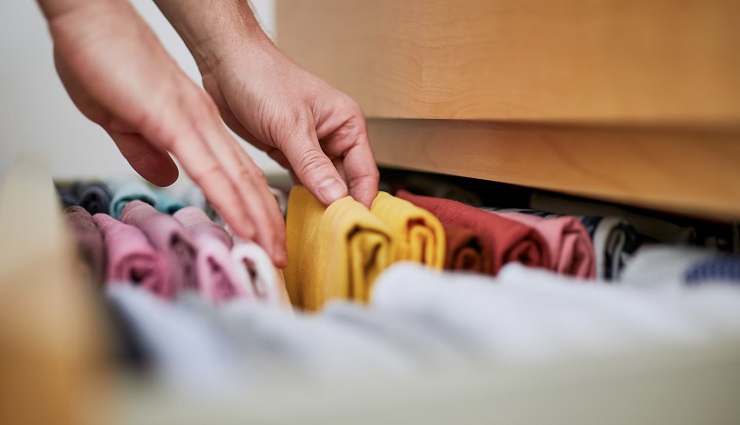To have clear and smooth skin, you must remove dead skin cells from your face. If you want to know how to remove dead skin cells, stay with us until the end of this article.
Dead skin cells
That part of our body’s skin that is scaly and falls off is called dead skin. Dead skin is the same cells regularly shed and replaced by new skin cells. Every day, 30,000 to 40,000 dead skin cells fall from our bodies, and new cells take their place. The natural cycle of replacing dead skin with new takes about 30 days.
Sometimes the dead skin cells don’t fall off naturally, resulting in the body’s skin becoming dark and scaly. You need to fix this problem to improve your skin condition.
Signs of dead skin formation
The first 18 to 23 layers of the skin are made up of dead skin cells. If these cells are not correctly removed from the skin, they will dry and have dark skin. Accumulation of dead skin has other symptoms in addition to dryness and darkening of the skin, such as:
- dry and peeling skin;
- itching;
- stiffness and thickening of the skin;
- Darkness and roughness of the skin;
- Acne and pimples.
What are the causes of the accumulation of dead skin cells?
During the natural skin exfoliation process, new skin cells are formed deep in the epidermis layer and come to the surface. The new cells that reach the surface push away the dead skin and take their place. But when this process goes slowly or when there is a disturbance, dead skin cells accumulate on the skin’s surface and cause skin problems.
What do you think is the most common reason for the accumulation of dead skin cells? In the following, we introduce other factors that cause the proliferation of dead skin cells on the skin’s surface.
1. age increasing
With age, the epidermal layer of the skin thins, and the speed of the cycle of replacing dead skin with new slows down. This problem is more common on the skin of the face and neck of women. The skin of babies and young children is bright and transparent due to the high speed of their skin cell cycle. Since children are increasing, their skin cell replacement rate is almost twice that of adults. Meanwhile, adults over 65 have at least one type of skin disorder.
2. Not cleaning the skin
Regular skin cleaning causes dead skin cells to accumulate, ready to be shed. If you don’t wash your face for several days, dead skin cells and fat get on your face and eventually lead to pimples and acne.
3. Weather and sunlight
Exposure to sunlight increases the rate of skin aging and skin cell death. As a result of these skin injuries, the skin’s surface accumulates dead cells. Sun damage appears in the form of wrinkles, age-related brown spots, and sagging skin.
4. dehydration
When your body is dehydrated, insufficient water reaches your skin, and the skin becomes dry and scaly. As a result, you will suffer from dryness, itching, and skin sensitivity.
5. skin diseases
In case of dead skin cells deterioration and excessive accumulation on the skin surface, visit a dermatologist because you may have some skin disease. Eczema and psoriasis are annoying skin diseases.
eczema

This inflammatory skin disease causes itchy red rashes all over the body. Eczema, also called atopic dermatitis, is a common skin disease in children, and dermatologists believe that the cause of eczema is a combination of genetics and environmental factors.
psoriasis
This skin disease, an autoimmune disease, causes the formation of thick sections of dead skin cells on the body’s skin, especially on the face. Scars and sensitive red spots on the skin result from this skin disease.
Although psoriasis cannot be completely cured, it can be well controlled. Consult a dermatologist for a proper treatment plan for this skin disease.
What is the method of preventing the accumulation of dead skin cells?
Although it is impossible to prevent the formation of dead skin cells, you can use methods to keep your skin clean and smooth.
1. Protect yourself from the sun
Take care of your skin with the right sunscreen and brimmed hats when you are out in the sun.
2. Avoiding smoking
Smoking increases the rate of skin aging and skin cell death.
3. healthy diet
You can keep your skin fresh and glowing by consuming plenty of fruits and vegetables rich in antioxidants. Refined carbohydrates and sugar damage the skin and cause it to darken.
4. Regular cleansing of the skin
By washing your face regularly, you can remove dead skin cells from it. If the washing and the materials used are mild, your skin will not be irritated.
Determining the best treatment method
The best way to remove dead skin cells is to see a dermatologist. He can offer you the best personal skin treatment plan by examining your skin. Of course, before you go to the doctor, list the treatments you have already done and the products you have used (such as retinoid creams) and let the specialist know about them. This will help your healing process. Also, you need to know your skin type to determine the best treatment for you.
Diagnosis of skin type
Dead skin cells make skin look dry, but any skin type can experience a build-up of dead skin cells. Skin types include:
- Normal skin: This type of skin is clear and uniform.
- Dry skin: dull and scaly.
- Oily skin: has a greasy or shiny appearance.
- Combination skin: parts of the skin are oily, and parts of it are dry.
- Sensitive skin: This type of skin usually becomes red and irritated after using skin care products
Methods of removing dead skin cells with various types of exfoliation
You can easily exfoliate your skin at home. Just be careful to use appropriate exfoliation according to your skin type.
1. Mechanical exfoliation
A tool such as a dry brush or coarse cloth is used in mechanical exfoliation to collect dead skin. This type of exfoliation is suitable for people with oily or thick skin. After you have cleansed your skin, run the cloth or brush over your skin. When you’re done, apply some lotion or moisturizer to your skin.
Microdermabrasion
Microdermabrasion is a type of mechanical exfoliation that is performed with professional tools and under the supervision of a dermatologist. In this method, the doctor uses tools to remove the dead skin, and the new skin is visible underneath.
2. Chemical peeling
Chemical peels use chemical products to remove dead skin cells. Chemicals such as alpha and beta hydroxy acids help to remove dead skin cells and are effective in evening out skin pigmentation. Mechanical exfoliation will be too harsh if you have dry or sensitive skin. Therefore, you can use a gentle chemical peeling method.
1. Alpha Hydroxy Acid (AHA)

This chemical exfoliator is usually used as a lotion or cream and often contains glycolic, lactic, or citric acid. Alpha hydroxy acid exfoliates the skin, makes skin color uniform and reduces possible dark spots.
Exfoliators usually make the skin very sensitive to sunlight, so it’s best to use a mild product to start exfoliating. It would be best to use an exfoliator daily to remove dead skin cells.
2. polyhydroxy acid (PHA)
Polyhydroxy acids are also good exfoliators for sensitive skin because they do not irritate it.
3. Beta Hydroxy Acid (BHA)
Beta hydroxy acids, better known as salicylic acid, can remove dead skin cells and improve the appearance of the skin. Also, these products can treat acne.
Beta hydroxy acid irritates the skin less than alpha hydroxy acid. Apply this product very gently on the skin for 30 seconds and wash your face with lukewarm water. Do not use hot or cold water, as it will irritate your skin.
4. Retinoid peels
By using products containing retinoids (a form of vitamin A) such as Differin (Adapalene), tretinoin, or retinol, you can remove dead skin from your face, and not only will your skin be free of pimples and acne, but it will also prevent premature aging.
Using any of the above products, you can prepare a homemade mask to remove dead skin cells.
Essential exfoliation tips
After exfoliation, use mild moisturizing creams to prevent skin drying and apply appropriate sunscreen if you have to go outdoors. After cleansing and removing dead skin cells, your skin is more sensitive to sunlight and burns.
Avoid all products that exfoliate using large particles such as salt, sugar, seeds, or nut shells when choosing either exfoliating method. Although these products are designed to remove dead skin cells, the size of the particles in them can cause tiny tears in the skin and eventually dry, sensitive, and even infected skin.
Removing dead skin from the soles of the feet
The skin of the soles of the feet is thicker than the skin of the face and neck and, therefore, less irritable. Consequently, you can be more aggressive in removing the dead skin on the soles of your feet and don’t worry about skin damage. With any of the following methods, you can clean the soles of your feet from dead skin.
- Exfoliate the soles of your feet using a high-quality foot scrub or brush.
- Always keep the soles of your feet soft and moist with moisturizer or foot creams. Of course, coconut oil can also be used. In this way, the dead skin is easily removed.
- Put your feet in warm water to soften the dead skin on the soles of your feet, and remove the dead skin with a rough cloth (like a bag) or a pumice stone.
last word
The formation of dead skin cells is typical and expected. But removing dead skin cells and taking care of them will prevent you from skin problems caused by accumulating these cells. How much do you care about your skin health? If you have any recommendations, please let us know.



